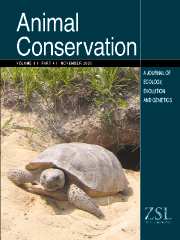Crossref Citations
This article has been cited by the following publications. This list is generated based on data provided by
Crossref.
Liu, Jianguo
Daily, Gretchen C.
Ehrlich, Paul R.
and
Luck, Gary W.
2003.
Effects of household dynamics on resource consumption and biodiversity.
Nature,
Vol. 421,
Issue. 6922,
p.
530.
Phillips, Judith
Nol, Erica
Burke, Dawn
and
Dunford, Wendy
2005.
Impacts of Housing Developments on Wood Thrush Nesting Success in Hardwood Forest Fragments.
The Condor,
Vol. 107,
Issue. 1,
p.
97.
Dunford, Wendy
and
Freemark, Kathryn
2005.
Matrix Matters: Effects of Surrounding Land Uses on Forest Birds Near Ottawa, Canada.
Landscape Ecology,
Vol. 20,
Issue. 5,
p.
497.
Radeloff, V. C.
Hammer, R. B.
Stewart, S. I.
Fried, J. S.
Holcomb, S. S.
and
McKeefry, J. F.
2005.
THE WILDLAND–URBAN INTERFACE IN THE UNITED STATES.
Ecological Applications,
Vol. 15,
Issue. 3,
p.
799.
Watson, James E. M.
Whittaker, Robert J.
and
Freudenberger, David
2005.
Bird community responses to habitat fragmentation: how consistent are they across landscapes?.
Journal of Biogeography,
Vol. 32,
Issue. 8,
p.
1353.
Phillips, Judith
Nol, Erica
Burke, Dawn
and
Dunford, Wendy
2005.
Impacts of Housing Developments on Wood Thrush Nesting Success in Hardwood Forest Fragments.
The Condor,
Vol. 107,
Issue. 1,
p.
97.
Smith, Courtland M.
and
Wachob, Douglas G.
2006.
Trends associated with residential development in riparian breeding bird habitat along the Snake River in Jackson Hole, WY, USA: Implications for conservation planning.
Biological Conservation,
Vol. 128,
Issue. 4,
p.
431.
Palomino, David
and
Carrascal, Luis M.
2006.
Urban influence on birds at a regional scale: A case study with the avifauna of northern Madrid province.
Landscape and Urban Planning,
Vol. 77,
Issue. 3,
p.
276.
Burhans, Dirk E.
and
Thompson, Frank R.
2006.
Songbird Abundance And Parasitism Differ Between Urban And Rural Shrublands.
Ecological Applications,
Vol. 16,
Issue. 1,
p.
394.
Chace, Jameson F.
and
Walsh, John J.
2006.
Urban effects on native avifauna: a review.
Landscape and Urban Planning,
Vol. 74,
Issue. 1,
p.
46.
Gonzalez-Abraham, Charlotte E.
Radeloff, Volker C.
Hammer, Roger B.
Hawbaker, Todd J.
Stewart, Susan I.
and
Clayton, Murray K.
2007.
Building patterns and landscape fragmentation in northern Wisconsin, USA.
Landscape Ecology,
Vol. 22,
Issue. 2,
p.
217.
Pidgeon, A. M.
Radeloff, V. C.
Flather, C. H.
Lepczyk, C. A.
Clayton, M. K.
Hawbaker, T. J.
and
Hammer, R. B.
2007.
ASSOCIATIONS OF FOREST BIRD SPECIES RICHNESS WITH HOUSING AND LANDSCAPE PATTERNS ACROSS THE USA.
Ecological Applications,
Vol. 17,
Issue. 7,
p.
1989.
Gonzalez-Abraham, Charlotte E.
Radeloff, Volker C.
Hawbaker, Todd J.
Hammer, Roger B.
Stewart, Susan I.
and
Clayton, Murray K.
2007.
PATTERNS OF HOUSES AND HABITAT LOSS FROM 1937 TO 1999 IN NORTHERN WISCONSIN, USA.
Ecological Applications,
Vol. 17,
Issue. 7,
p.
2011.
MacGregor-Fors, Ian
2008.
Relation between habitat attributes and bird richness in a western Mexico suburb.
Landscape and Urban Planning,
Vol. 84,
Issue. 1,
p.
92.
PETERSON, M. NILS
CHEN, XIAODONG
and
LIU, JIANGUO
2008.
Household Location Choices: Implications for Biodiversity Conservation.
Conservation Biology,
Vol. 22,
Issue. 4,
p.
912.
Mattsson, B. J.
and
Niemi, G. J.
2008.
Causes and consequences of distribution patterns in a migratory songbird across its geographic range.
Canadian Journal of Zoology,
Vol. 86,
Issue. 4,
p.
314.
McKinney, Richard A.
and
Paton, Peter W. C.
2009.
Breeding birds associated with seasonal pools in the northeastern United States.
Journal of Field Ornithology,
Vol. 80,
Issue. 4,
p.
380.
Bock, Carl E.
and
Bock, Jane H.
2009.
The Planner¿s Guide to Natural Resource Conservation:.
p.
59.
Johnson, Yara Sánchez
Hernández, Fidel
Hewitt, David G.
Redeker, Eric J.
Waggerman, Gary L.
Meléndez, Heriberto Ortega
Zamora Treviño, Héctor V.
and
Roberson, Jay A.
2009.
Status of White-Winged Dove Nesting Colonies in Tamaulipas, México.
The Wilson Journal of Ornithology,
Vol. 121,
Issue. 2,
p.
338.
Gagné, Sara A.
and
Fahrig, Lenore
2011.
Do birds and beetles show similar responses to urbanization?.
Ecological Applications,
Vol. 21,
Issue. 6,
p.
2297.


